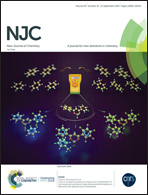New o-substituted diphenylphosphinic amide ligands: synthesis, characterization and complexation with Zn2+, Cu2+ and Y3+†
Abstract
Phosphinic amide derivatives have drawn significant attention in coordination chemistry and have been incorporated into the design and synthesis of new ligands. In this work, the combination of the diphenylphosphinic amide group with quinoline, pyridine and phosphoramidate moieties gave rise to four new classes of ligands (6, 8, 11 and 13), in moderate to good yields. The coordination properties were tested with Zn2+, Cu2+ and Y3+ by nuclear magnetic resonance (NMR), fluorescence and infrared (IR) spectroscopies. The molar proportions between metal ions and ligands (M/L) were estimated from the spectrofluorimetric titration curves and have demonstrated preponderant formation of ML2-type complexes. From the IR spectra, the variations of wavenumber and/or intensity of the absorption bands of ligands and complexes pointed out the participation of P![[double bond, length as m-dash]](https://www.rsc.org/images/entities/char_e001.gif) O, C
O, C![[double bond, length as m-dash]](https://www.rsc.org/images/entities/char_e001.gif) O, C
O, C![[double bond, length as m-dash]](https://www.rsc.org/images/entities/char_e001.gif) N(pyridine) and N–H functional groups as the possible coordination sites. The results have demonstrated the capacity of some of the synthesized substances to act as ligands, which can be useful for several applications in the field of coordination chemistry.
N(pyridine) and N–H functional groups as the possible coordination sites. The results have demonstrated the capacity of some of the synthesized substances to act as ligands, which can be useful for several applications in the field of coordination chemistry.



 Please wait while we load your content...
Please wait while we load your content...